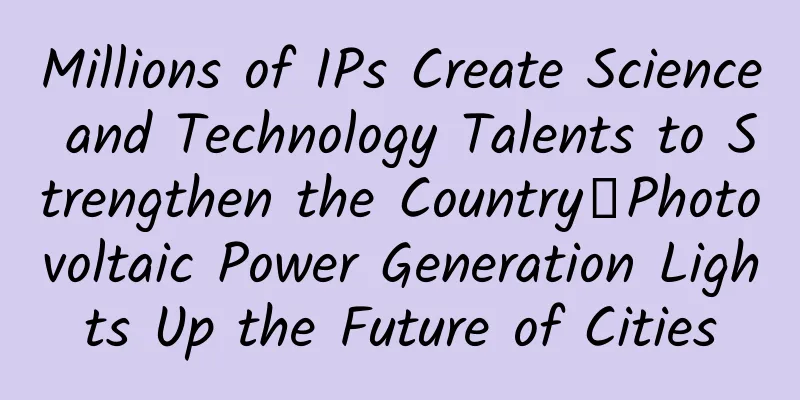Millions of IPs Create Science and Technology Talents to Strengthen the Country丨Photovoltaic Power Generation Lights Up the Future of Cities

|
Photovoltaic power generation is a renewable energy technology. Its core lies in directly converting solar energy into electrical energy through the photovoltaic effect, providing human society with a green, clean and sustainable energy solution. Photovoltaic power generation not only helps to reduce dependence on fossil fuels, but also significantly reduces greenhouse gas emissions and combats climate change. Photovoltaic power generation has the characteristics of distributed power generation and can be flexibly applied to various scenarios such as urban buildings, municipal projects, and public facilities, providing a more diversified and greener option for urban energy supply. In recent years, my country has continuously promoted the development of photovoltaic technology. The intelligence and automation level of photovoltaic systems has also been continuously improved. Through the integrated application of cloud computing, big data, Internet of Things and other technologies, remote monitoring, intelligent operation and maintenance, and fault warning of photovoltaic power stations have been realized, greatly improving the power generation efficiency and operation and maintenance efficiency. In addition, the lightweight and flexible design of photovoltaic modules also makes it possible for them to be widely used in urban buildings. Urban construction and renovation are important opportunities to promote green and low-carbon urban development. By introducing new technologies and concepts such as green buildings and clean energy, urban energy consumption and carbon emissions can be significantly reduced, the quality of urban ecological environment can be improved, and a more livable living environment can be created for residents. In March 2024, the National Development and Reform Commission and the Ministry of Housing and Urban-Rural Development issued the "Work Plan for Accelerating Energy Conservation and Carbon Reduction in the Construction Sector". The plan clearly states that by 2025, the energy conservation and carbon reduction system in the construction sector will be more sound, new urban buildings will fully implement green building standards, the area of new ultra-low energy consumption and near-zero energy consumption buildings will increase by more than 20 million square meters compared to 2023, and the area of energy-saving renovation of existing buildings will increase by more than 200 million square meters compared to 2023. In this regard, the two departments proposed 12 key tasks, including "piloting the promotion of photovoltaic integration construction in new buildings such as industrial plants, public buildings, and residential buildings" and "strengthening the management of photovoltaic system installation in existing buildings." In urban construction projects, the application of distributed photovoltaic power stations and building integrated photovoltaic construction (BIPV) is becoming more and more widespread. They can not only provide clean electricity supply for urban buildings, but also achieve a win-win situation of economic and environmental benefits through the mode of "self-generation and self-use, surplus electricity to the grid". BIPV projects are used in the roofs, walls and other locations of urban buildings to generate electricity using solar energy to meet the electricity needs of the buildings themselves. BIPV project technology is combined with smart microgrid technology to form an independent energy supply system. In the event of a power grid failure or power outage, photovoltaic power stations provide emergency power supply for buildings, improving the reliability and resilience of the city's power supply. As a key area to promote the coordinated development of Beijing, Tianjin and Hebei, Xiongan New Area has attracted much attention for its urban renewal and transformation project. As the first major infrastructure project started in Xiongan New Area, Xiongan Station is a railway station that "generates electricity". A total of 42,000 square meters of polycrystalline silicon photovoltaic modules are laid on the roof of the station, with a total installed capacity of 5.97 megawatts. Since it was officially connected to the grid for power generation in December 2020, it has generated more than 15 million kWh of electricity, with an average annual power generation of 5.8 million kWh. The project not only provides clean electricity supply for Xiongan High-speed Railway Station, but also maximizes economic benefits through the "photovoltaic storage and charging" model. At the same time, the photovoltaic power generation project has also produced significant environmental benefits, saving 1,800 tons of standard coal and reducing carbon dioxide emissions by 4,500 tons per year. In order to quantify and realize the environmental rights and interests formed by photovoltaic power generation, State Grid Xiongan Integrated Energy Company also jointly compiled the "Carbon Reduction Product Methodology for Distributed Photovoltaic Projects in Xiongan New Area" with domestic teams, filling the gap in the carbon reduction product methodology for distributed photovoltaic projects in Hebei Province. As the world pays more and more attention to environmental protection and sustainable development, distributed photovoltaic power stations, as representatives of green and clean energy, will play an increasingly important role in urban construction and renovation. Through continuous technological innovation and application practice, photovoltaic power stations will provide cities with more green, reliable and economical energy solutions, and promote cities to move towards green and low-carbon. In the future, we have reason to believe that distributed photovoltaic power stations will bloom in more cities in my country and contribute to the sustainable development of mankind. Text: Peng Bo, Senior Engineer of MCC General Research Institute of Building Research Co., Ltd. Reviewer: Ge Ben, Associate Professor, China University of Mining and Technology |
<<: Is conjunctivitis contagious just by looking at it?
Recommend
These 3 "face washing mistakes" are quietly ruining your face! Doctors suggest: The correct way to wash your face →
November 7th of each year is World Beauty Day, wh...
It turns out that Xuefu Zhuyu Pills have so many uses
Xuefu Zhuyu Pills are widely used in daily life. ...
Sound in the trachea when breathing
When you breathe, if there is a sound in the trac...
Burn more fat? Be healthier? Which one should you choose: outdoor running or running in the gym?
Another spring is here. Attracted by the beautifu...
Is faster-than-light travel coming? Don't worry, listen to what the experts say
The theory of relativity requires that "the ...
Trans fats are more terrible than sugar, and they are in the food you often eat! Let’s read the “confession” of trans fatty acids
Author: Bo Chunyan Jiujiang First People's Ho...
Japan plans to speed up the discharge of nuclear wastewater into the sea, and Koreans are buying salt like crazy! Should we worry?
On July 4, the International Atomic Energy Agency...
What are the effects of Pangdahai and honeysuckle?
Sterculia lychnophora and honeysuckle are two com...
Help! Did this fish steal grandpa’s dentures?
Produced by: Science Popularization China Produce...
The Essence of Gravitation
The concept of gravity Gravity is the interaction...
There are several varieties of Panax notoginseng
Panax notoginseng, also known as Sanqi, is a famo...
The online sale of atropine, the "miracle drug for myopia", has been suspended! Can children still use it? Experts remind us:
Recently, Shenyang Xingqi Eye Hospital announced ...
The efficacy and function of Doubanxiang
Doubanxiang is a very good medicinal ingredient. ...
Black Myth wins the award! How is the most realistic physics engine in the game achieved? It's incredible...
This year, our domestic game "Black Myth: Wu...
Why are there vitamins E and K, but no vitamins FG, H, I, and J?
We are all familiar with vitamins ABCDE, but if w...









